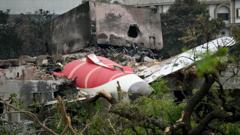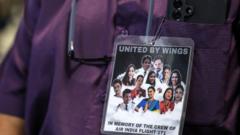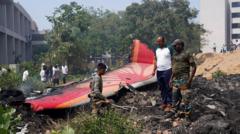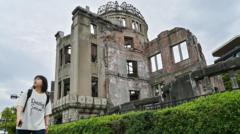In a devastating aviation catastrophe, an Air India Boeing 787-8 Dreamliner tragically crashed shortly after departure from Ahmedabad, India, resulting in over 260 fatalities. The aircraft appeared to lose altitude unexpectedly, raising questions about why it descended so rapidly after takeoff. This incident marks India's most severe aviation incident since 1996, reverberating across the globe. One survivor, identified as a British citizen, emerged from the wreckage amidst the chaos. The incident has highlighted concerns surrounding the safety record of the Dreamliner model, which has previously gone without any fatal crash history. As investigators scramble to understand the crash's cause, local officials have reported extensive damage at the crash site, where the plane collided with a medical college's dining hall, igniting a massive blaze.
**Tragedy Strikes: Record Death Toll in Air India Crash**

**Tragedy Strikes: Record Death Toll in Air India Crash**
A catastrophic incident claims over 260 lives in one of India's worst aviation disasters.
The full story unfolds below.
---
An Air India passenger jet tragically crashed into a medical college dining hall just moments after taking off from Ahmedabad, India, resulting in a staggering loss of life with more than 260 people confirmed dead. This incident marks the deadliest aviation disaster in India since 1996. Reports indicate that the airplane, a Boeing 787-8 Dreamliner bound for London Gatwick Airport, was carrying 242 passengers, including a mix of nationalities: 169 Indian citizens, 53 British nationals, seven Portuguese, and one Canadian.
Surprisingly, amidst the chaos, one British citizen managed to survive. Visuals from the accident scene revealed a man, later identified as Viswash Kumar Ramesh, who stated he came from “inside” the plane, showcasing the horror of the incident firsthand.
Investigations into the cause of the crash are underway, though experts warn that it could take months or even years to ascertain the specifics. Questions are being raised concerning the Dreamliner's descent just after takeoff, as the aircraft has faced significant scrutiny over the years despite never having been involved in a fatal crash until now.
At the crash location, officials reported that the jet likely skidded off its path after descending, causing extensive damage to the B.J. Medical College before erupting into flames. The gravity of this incident has sent shockwaves throughout both India and the global aviation community, highlighting the ongoing need for stringent safety measures and protocols.
As the investigation continues, more maps and photographs of the site have emerged, shedding light on the immediate aftermath of this tragic event.
---
An Air India passenger jet tragically crashed into a medical college dining hall just moments after taking off from Ahmedabad, India, resulting in a staggering loss of life with more than 260 people confirmed dead. This incident marks the deadliest aviation disaster in India since 1996. Reports indicate that the airplane, a Boeing 787-8 Dreamliner bound for London Gatwick Airport, was carrying 242 passengers, including a mix of nationalities: 169 Indian citizens, 53 British nationals, seven Portuguese, and one Canadian.
Surprisingly, amidst the chaos, one British citizen managed to survive. Visuals from the accident scene revealed a man, later identified as Viswash Kumar Ramesh, who stated he came from “inside” the plane, showcasing the horror of the incident firsthand.
Investigations into the cause of the crash are underway, though experts warn that it could take months or even years to ascertain the specifics. Questions are being raised concerning the Dreamliner's descent just after takeoff, as the aircraft has faced significant scrutiny over the years despite never having been involved in a fatal crash until now.
At the crash location, officials reported that the jet likely skidded off its path after descending, causing extensive damage to the B.J. Medical College before erupting into flames. The gravity of this incident has sent shockwaves throughout both India and the global aviation community, highlighting the ongoing need for stringent safety measures and protocols.
As the investigation continues, more maps and photographs of the site have emerged, shedding light on the immediate aftermath of this tragic event.






















